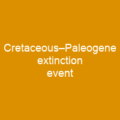Dinosaurs: The Majestic Giants of the Mesozoic Era
Imagine a world where towering giants roamed the land, their scales shimmering under the sun’s rays, and their mighty footsteps echoing through ancient forests. These are the dinosaurs, the awe-inspiring creatures that first appeared during the Triassic period, around 243 to 233 million years ago. How could such magnificent beings have once walked our planet?
Dinosaurs were not just a single group but a diverse and varied collection of reptiles. They dominated the terrestrial vertebrates for over 160 million years, from the Triassic to the Cretaceous periods. The two main groups are avian dinosaurs (birds) and non-avian dinosaurs. Birds evolved from earlier theropods during the Late Jurassic epoch and are the only dinosaur lineage known to have survived the Cretaceous–Paleogene extinction event.
These magnificent creatures ranged in size, with some species being as large as 39 meters long and others small, around 50 centimeters. Many dinosaurs had display structures such as horns or crests, and some developed skeletal modifications like bony armor and spines. The first dinosaur fossils were recognized in the early 19th century, and since then, mounted fossil dinosaur skeletons have been major attractions at museums worldwide.
But what exactly defines a dinosaur? Dinosaurs are defined as the group consisting of the most recent common ancestor of Triceratops and modern birds (Neornithes), and all its descendants. They include major groups such as ankylosaurians, stegosaurians, ceratopsians, pachycephalosaurians, ornithopods, theropods, and sauropodomorphs.
And let’s not forget the enduring impact of dinosaurs on popular culture. The discovery of non-avian dinosaur remains above the K-Pg boundary has been interpreted as evidence of Paleocene survivors, but this is disputed by some researchers who believe that these finds are reworked and unreliable. The cultural importance of dinosaurs has led to significant public funding for paleontology and has made them an enduring part of human culture.
The Evolutionary Journey
From the Middle to Late Triassic epochs, around 20 million years after the Permian-Triassic extinction event, dinosaurs diverged from their archosaur ancestors. They coexisted with non-dinosaurian ornithodirans for a period of time before becoming dominant terrestrial animals. The first few lines of early dinosaurs diversified during the Carnian and Norian stages of the Triassic, possibly by occupying niches left by extinct groups.
During the Late Triassic and Early Jurassic, dinosaurs were connected as a single landmass Pangaea and had a worldwide fauna mostly composed of coelophysoid carnivores and early sauropodomorph herbivores. By the Middle and Late Jurassic, dinosaurian faunas became more diverse with predators consisting of ceratosaurians, megalosauroids, and allosauroids, and herbivores consisting of stegosaurian ornithischians and large sauropods.
In the Early Cretaceous, dinosaurs were strongly differentiated by landmass. Ankylosaurians, iguanodontians, and brachiosaurids spread through Europe, North America, and northern Africa. Theropods in Asia became maniraptoran coelurosaurians like dromaeosaurids, troodontids, and oviraptorosaurians, while Australia was home to basal ankylosaurians, hypsilophodonts, and iguanodontians.
The Early Cretaceous saw the evolution of flowering plants, which would be amplified in the Late Cretaceous. Dinosaurs evolved more sophisticated ways to orally process food, with ceratopsians developing a method of slicing with teeth stacked on each other and iguanodontians refining a method of grinding with dental batteries.
The Fossil Record
From the fossil record, we can piece together the lives of these ancient creatures. The first evidence for herding or flocking behavior among dinosaurs was found in the 1878 Iguanodon discovery in Bernissart, Belgium. Those, along with multiple trackways, suggest that gregarious behavior was common in many early dinosaur species.
One of the most valuable dinosaur fossils was discovered in the Gobi Desert in 1971. It included a Velociraptor attacking a Protoceratops, providing evidence that dinosaurs did indeed attack each other. Additional evidence for active aggressive confrontations is the partially healed tail of an Edmontosaurus.
Modern birds communicate by visual and auditory signals, and the wide diversity of visual display structures among fossil dinosaur groups suggests that visual communication has always been important in dinosaur biology. Reconstruction of the plumage color of Anchiornis suggest the importance of color in visual communication in non-avian dinosaurs.
Behavioral Insights
The science of biomechanics, pioneered by Robert McNeill Alexander, has provided significant insight into how dinosaurs moved on the ground. For example, studies of the forces exerted by muscles and gravity on dinosaurs’ skeletal structure have investigated how fast dinosaurs could run, whether diplodocids could create sonic booms via whip-like tail snapping, and whether sauropods could float.
Modern birds are arboreal (tree climbing), and this was also true of many Mesozoic birds. However, most non-avialan dinosaurs seem to have relied on land-based locomotion. A good understanding of how dinosaurs moved on the ground is key to models of dinosaur behavior.
Parental Care
The production of medullary tissue is a general characteristic of all dinosaurs, and there is evidence of parental care for young after hatching among some dinosaur species. Genital structures rarely fossilize, but a 2021 specimen of Psittacosaurus showed lateral swellings and pigmented regions that may have been used for social displays.
Endothermy and Metabolism
The brain size of dinosaurs was often thought to be small due to Marsh’s 1896 calculations, but later research showed that this was not the case when compared to living reptiles. In fact, relative brain size increased during the evolution of theropods.
Extinction and Legacy
The bolide impact hypothesis attributes the K-Pg extinction event to a bolide (extraterrestrial projectile) impact. A crater measuring 180 km wide was discovered in the Yucatán Peninsula, Mexico, and is thought to have formed as a result of the impact. The Deccan Traps flood basalts of India were actively erupting at the time of the K-Pg extinction.
The discovery of non-avian dinosaur remains above the K-Pg boundary has been interpreted as evidence of Paleocene survivors, but this is disputed by some researchers who believe that these finds are reworked and unreliable. The cultural importance of dinosaurs has led to significant public funding for paleontology and has made them an enduring part of human culture.
The popularity of dinosaurs has resulted in the development of dinosaur exhibits, which have driven scientific discoveries and fueled public enthusiasm. The competition between museums for public attention during this time led to the Bone Wars, a period of intense paleontological research that produced significant contributions to the field. The popular fascination with dinosaurs has led to their appearance in literature, film, and other media.
The origins of dinosaurs in popular culture date back to 1852, with Dickens’ mention of them. Since then, numerous books, films, and other media have featured dinosaurs, including novels like Jurassic Park by Michael Crichton and iconic films like King Kong and Godzilla. Dinosaurs are also referenced in non-fiction works about science, such as books written by paleontologists.

In conclusion, dinosaurs are more than just fossils—they represent a fascinating chapter in Earth’s history. From their first appearance during the Triassic period to their dominance throughout the Mesozoic Era and beyond, these magnificent creatures have left an indelible mark on our understanding of life on Earth. As we continue to uncover new insights through scientific research and exploration, dinosaurs remain a source of wonder and inspiration for generations to come.
You want to know more about Dinosaur?
This page is based on the article Dinosaur published in Wikipedia (retrieved on February 8, 2025) and was automatically summarized using artificial intelligence.







